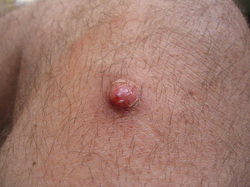Skin Cancer

Cancer is described as an uncontrolled growth or division of cells. Skin cancer is a generic term for any cancer that arises from the skin. This can include melanoma, and carcinoma (basal cell, squamous cell). When determining abnormality of skin lesions the ABCDE rule is often employed. This would include: asymmetry, border irregularity, color, diameter, elevation (to a lesser degree). Other findings/history used to help the the diagnosis would include pain, duration of a lesion, acute or chronic changes, wounds, fixation to underlying structures, similar lesions in other locations, family history, skin type etc.
Basal cell carcinomas the most common type of skin cancer. It is typically seen as a raised bump or sore that is not healing. It usually grows slowly and rarely spreads. It is most often found on areas with sun exposure such as the ears, nose, and face.
Squamous cell carcinoma is often demonstrated as a thick red scaly patch or bleeding ulcer, the chances of metastasis (spreading) are higher than that of basal cell carcinoma but less than melanoma. It is also thought to be caused by sun exposure.
Melanoma is the most serious of the skin cancer as it grows beneath the superficial skin and is often associated with pigmentation (color).
After a thorough history and physical evaluation your foot and ankle Doctor will be able to help you understand if skin cancer is suspected and provide a treatment plan best suited for the removal and treatment of your cancer. Often a biopsy of the lesion is performed to allow for a more definitive diagnosis as there is a wide variability in presentation. If the diagnosis of skin cancer is found often an oncologist is involved in a team approach for best overall care.
Basal cell carcinomas the most common type of skin cancer. It is typically seen as a raised bump or sore that is not healing. It usually grows slowly and rarely spreads. It is most often found on areas with sun exposure such as the ears, nose, and face.
Squamous cell carcinoma is often demonstrated as a thick red scaly patch or bleeding ulcer, the chances of metastasis (spreading) are higher than that of basal cell carcinoma but less than melanoma. It is also thought to be caused by sun exposure.
Melanoma is the most serious of the skin cancer as it grows beneath the superficial skin and is often associated with pigmentation (color).
After a thorough history and physical evaluation your foot and ankle Doctor will be able to help you understand if skin cancer is suspected and provide a treatment plan best suited for the removal and treatment of your cancer. Often a biopsy of the lesion is performed to allow for a more definitive diagnosis as there is a wide variability in presentation. If the diagnosis of skin cancer is found often an oncologist is involved in a team approach for best overall care.